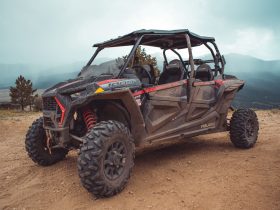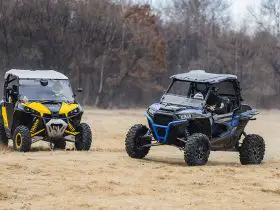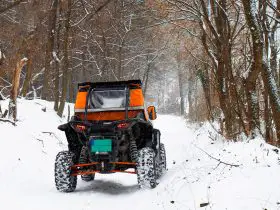One of the things that distinguish UTVs from most of the other four-wheeled vehicles is that its front tires are smaller than the ones on the rear. A casual glance at a side-by-side might not reveal this feature since the tire size differs only in width, not diameter.
So, when you check the tire designation consisting of three numbers, it’s usually only the middle one that varies depending on where it’s meant to be mounted. It’s the number marking the width of the tire, while the first one stands for height and the last one is the rim diameter. Most of the new stock side-by-sides straight from the factory come with 9″ width on the front and 11″ at the back.
So, why are UTV tires smaller in the front? TL; DR version is that narrower front tires make for easier and more responsive steering, while wider tires at the rear provide better contact with the surface, and, thus, better traction. But, the fact that some newer sporty UTV models don’t come with staggered (different front and rear sizes) setup tells us that things are a bit more complicated. For example, Textron’s Wildcat XX and Polaris RZR XXP Turbo S are running with four same tires. Also, some of the owners are choosing to replace the front tires with the ones matching the rear size.
We’ll try to explain the pros and cons of staggered tires, so you can have a better understanding of what the manufacturers are going for by placing smaller tires on the front end of a side-by-side.
Table of Contents
Benefits of Smaller Front Tires on UTV
Steering
Having less width means that less of the tire’s surface is making contact to the ground. This makes UTV easier to steer, especially models without power steering. Reducing steering effort results in easier maneuvering and turning. Even vehicles that feature power steering, which is pretty much standard now, are much smoother to steer with staggered tires. The front part of the vehicle is lighter, making it less difficult to move from side to side.
Side-by-side makes use of narrower tires to lessen the effect of weight when it comes to steering. You can best understand this if you put two objects of similar weight, but different surface area sizes, on the table, and try rotating them. You can see how much easier it is to maneuver the smaller object.
Cornering and Handling
Having smaller tires on the front side of a UTV improves the actual response of the vehicle to the rider’s actions as well as its movement along the track.
This is particularly useful for those UTV-ers who enjoy a more challenging ride. When driving between rock or around tight and sharp corners, it’s essential to hit the right path and gain traction and momentum. If you ride dirt or muddy trails, the front tire, due to being thinner, will dig deeper into the ground. This way the rear tire will be the first to lose grip, enabling experienced riders better control over their vehicle. Less slipping on the front end will enable you to attack and handle corners better. Also, smaller front tires allow for skinnier design, making navigation through rocks or other obstacles easier.
Traction
More width on the rear tires equals more surface to grip the terrain equals more control over the four-wheeler. Better control, especially coming out of a turn provides better acceleration, which is essential for racing where every millisecond matters. Torque and grin that wider tires provide are also very useful when it comes to hill climbing.
Rear tires traction also benefits from the smaller width of front tires, particularly in muddy conditions. As the front tires dig into the mud they push a good deal of it behind, leaving the rut of firmer ground for the back tires to grip onto.
Aesthetics and Design
Some riders simply prefer the look of a UTV with smaller front tires, Skinny front end indeed gives your vehicle a slicker, meaner and more aggressive appearance. Especially since it’s the traditional look of UTVs and ATVs.
Besides pure cosmetics, there are some practical design benefits to the narrower tires at the front end. Unlike their rear partners, front tires turn. That means that they need more space around them than those at the back. Keeping them a bit thinner allows for more compact design and decreases the overall weight of the vehicle.
Cleanliness
The benefit of having smaller tires at the front of the vehicle that often gets overlooked is cleanliness. Both of your UTV and yourself. A bit thinner tires can make a whole lot of difference to the amounts of slinging mud, water, dirt, rocks, and debris. They will keep most of it under the fender, where it should be. While greater width would probably end with you covered in mud from head to toe. Since the front tires turn, the fenders on the front would have to be wider than those on the rear if you’re using the same size tires, which would further mess with overall weight and stability. Keep this in mind if you’re thinking about mounting wider tires on the frontal side.
The Disadvantages of Smaller Front Tires on UTV
Tire Rotation
Many UTV users try to prolong the tread life of their tires by rotating them. This provides equal wear and tear on all four tires. Of course, if you have staggered tires this is not possible due to the size difference. You can try it bu it’s far from the best course of action. Putting smaller tires on the rear will result in losing grip and traction and you risk rubbing the fender while putting bigger ones at the front will make steering much harder.
Spare Tires
Most of UTV’s have room for only one spare tire. Or you can try packing two, but that means losing valuable space for equipment and other stuff you usually carry in your dump-bed. Staggering your tires further complicates this issue. If you blow a front tire, you can’t replace it with the spare in the same size as the back tire.
It’ still probably for the best that the spare tire you carry is the front one. When you blow a tire, your day of riding is most likely over. But, if you have a flat front, you’ll be able to ride with it to some extent, for a shorter period of time, And if you have to replace the rear tire, mounting the spare front tire will serve you good enough to get you home where you can fix it or put on a proper replacement.
Limited Aftermarket Availability
If you try to shop for aftermarket staggered tires, you’ll notice that your options are somewhat limited. Especially if you move up in height looking for larger tires. This is particularly the case with DoT (Department of Transportation) approved tires.
Height
The difference in height that staggered tires bring is less of an issue than it may sound. Although nominally the same height, there is usually up to 1/2 inch difference between the front and the rear. It’s not something you’ll likely notice during the ride, or at all unless you are an OCD person. After all stock vehicles with staggered tires are designed to be that way. On the other hand, if you decide to tinker with the UTV that came from the factory with 4 same size tires and put the thinner tires upfront, it may affect your drive’s stability and the tear and wear of the vehicle components, such as drive belt, clutch, and axle.
Going with 4 Same-Size Tires
As we mentioned, some of the newer machines feature al 4 four tires of the same size. A lot of people upgrading their ride choose to go with this option. But This way you can avoid some of the downsides of having staggered tires. The tire rotation and spare tire issues are gone, and you can find many more aftermarket options to choose from. On the other hand, gone are some of the benefits. Steering will be much more difficult, and if your vehicle doesn’t have power steering you will probably have to pony up some cash for that too. Also, count on replacing factory rims with aftermarket ones. As you can see the costs pile up pretty quickly so think carefully before deciding on going with this option.
Are the UTV’s with Smaller Front Tires Right for You?
This entirely depends on your needs and preferred riding style. Staggered tires are perfect for sand and dune riding. Skinny front tires dig deep through the sand, with as little friction as possible, while wide back tires provide traction. We’ve already explained some of the advantages of smaller front tires when riding on muddy terrain – more ground clearance for back tires friction and a cleaner ride.
Whatever you decide, make sure you did your research. Ask in the local UTV workshop about the process and price of replacing your small front tires with bigger ones. Consult fellow riders on their experiences. This way you can avoid unnecessary damage to your UTV, spending a significant amount of money or ruining the enjoyment of your ride.









